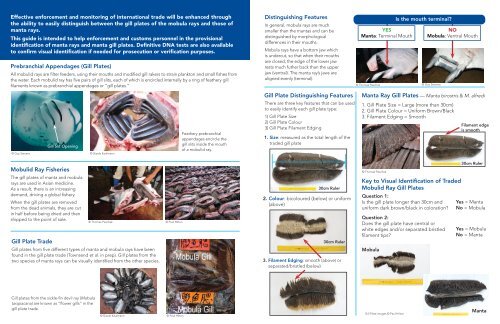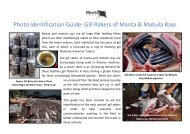Mobulid Gill Plate Identification Guide (Print Version) - Manta Trust
Mobulid Gill Plate Identification Guide (Print Version) - Manta Trust
Mobulid Gill Plate Identification Guide (Print Version) - Manta Trust
Create successful ePaper yourself
Turn your PDF publications into a flip-book with our unique Google optimized e-Paper software.
Effective enforcement and monitoring of international trade will be enhanced through<br />
the ability to easily distinguish between the gill plates of the mobula rays and those of<br />
manta rays.<br />
This guide is intended to help enforcement and customs personnel in the provisional<br />
identification of manta rays and manta gill plates. Definitive DNA tests are also available<br />
to confirm visual identification if needed for prosecution or verification purposes.<br />
Prebranchial Appendages (<strong>Gill</strong> <strong>Plate</strong>s)<br />
All mobulid rays are filter feeders, using their mouths and modified gill rakers to strain plankton and small fishes from<br />
the water. Each mobulid ray has five pairs of gill slits, each of which is encircled internally by a ring of feathery gill<br />
filaments known as prebranchial appendages or “gill plates.”<br />
<strong>Mobulid</strong> Ray Fisheries<br />
The gill plates of manta and mobula<br />
rays are used in Asian medicine.<br />
As a result, there is an increasing<br />
demand, driving a global fishery.<br />
When the gill plates are removed<br />
from the dead animals, they are cut<br />
in half before being dried and then<br />
shipped to the point of sale.<br />
<strong>Gill</strong> <strong>Plate</strong> Trade<br />
<strong>Gill</strong> Slit Opening<br />
© Guy Stevens © Gisela Kaufmann<br />
<strong>Gill</strong> plates from five different types of manta and mobula rays have been<br />
found in the gill plate trade (Townsend et al. in prep). <strong>Gill</strong> plates from the<br />
two species of manta rays can be visually identified from the other species.<br />
<strong>Gill</strong> plates from the sickle-fin devil ray (Mobula<br />
tarapacana) are known as “flower gills” in the<br />
gill plate trade.<br />
© Thomas Peschak © Paul Hilton<br />
© Gisela Kaufmann © Paul Hilton<br />
Feathery prebranchial<br />
appendages encircle the<br />
gill slits inside the mouth<br />
of a mobulid ray.<br />
Distinguishing Features<br />
In general, mobula rays are much<br />
smaller than the mantas and can be<br />
distinguished by morphological<br />
differences in their mouths.<br />
Mobula rays have a bottom jaw which<br />
is undercut, so that when their mouths<br />
are closed, the edge of the lower jaw<br />
rests much futher back than the upper<br />
jaw (ventral). The manta ray’s jaws are<br />
aligned evenly (terminal).<br />
<strong>Gill</strong> <strong>Plate</strong> Distinguishing Features<br />
There are three key features that can be used<br />
to easily identify each gill plate type:<br />
1) <strong>Gill</strong> <strong>Plate</strong> Size<br />
2) <strong>Gill</strong> <strong>Plate</strong> Colour<br />
3) <strong>Gill</strong> <strong>Plate</strong> Filament Edging<br />
1. Size: measured as the total length of the<br />
traded gill plate<br />
30cm Ruler<br />
2. Colour: bicoloured (below) or uniform<br />
(above)<br />
30cm Ruler<br />
3. Filament Edging: smooth (above) or<br />
separated/bristled (below)<br />
YES<br />
<strong>Manta</strong>: Terminal Mouth<br />
© Thomas Peschak<br />
<strong>Manta</strong> Ray <strong>Gill</strong> <strong>Plate</strong>s — <strong>Manta</strong> birostris & M. alfredi<br />
1. <strong>Gill</strong> <strong>Plate</strong> Size = Large (more than 30cm)<br />
2. <strong>Gill</strong> <strong>Plate</strong> Colour = Uniform Brown/Black<br />
3. Filament Edging = Smooth<br />
© Thomas Peschak<br />
Is the mouth terminal?<br />
Key to Visual <strong>Identification</strong> of Traded<br />
<strong>Mobulid</strong> Ray <strong>Gill</strong> <strong>Plate</strong>s<br />
Question 1:<br />
Is the gill plate longer than 30cm and<br />
uniform dark brown/black in coloration?<br />
Question 2:<br />
Does the gill plate have central or<br />
white edges and/or separated bristled<br />
filament tips?<br />
Mobula<br />
<strong>Gill</strong> <strong>Plate</strong> images © Paul Hilton<br />
NO<br />
Mobula: Ventral Mouth<br />
© Guy Stevens<br />
Filament edge<br />
is smooth<br />
30cm Ruler<br />
Yes = <strong>Manta</strong><br />
No = Mobula<br />
Yes = Mobula<br />
No = <strong>Manta</strong><br />
<strong>Manta</strong>



